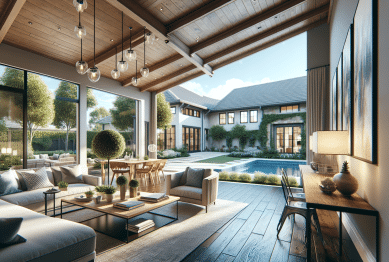Curious about why smart homes dominate conversations in real estate and housing? This article explores how intelligent technology, energy savings, and home automation are changing the way people buy, sell, and upgrade homes. Discover what drives this trend and what buyers notice first when looking at connected living spaces.
What Drives the Popularity of Smart Homes
The real estate industry is seeing a marked shift toward smart homes, with buyers and sellers both eager to explore connected living. These homes tap into automated systems that manage lights, temperature, security, and even appliances with the tap of a phone or voice command. Many attribute the surge to increased awareness about energy efficiency and security. Voice-activated controls and remote access have made daily routines simpler, helping smart homes stand out in property listings. A big part of the draw is the promise of reducing utility costs and increasing peace of mind.
For homebuyers, smart features can provide reassurance that their investment is both modern and future-ready. Home automation now includes features like programmable thermostats, automated blinds, and even leak sensors. Not only do these additions offer convenience, they often serve as decision points for prospective owners. The combination of technology and comfort helps homes sell faster and fetch higher prices in competitive markets. Potential savings and easy customization appeal to tech-savvy families and newcomers alike.
From a seller’s perspective, adding smart devices can make a property more marketable. Research from the National Association of Realtors notes that many buyers consider home automation to be a value-adding upgrade (Source: https://www.nar.realtor/research-and-statistics/quick-real-estate-statistics). Realtors now highlight these features in marketing materials, and some regions see higher demand for connected homes. The growing ecosystem for devices—from lighting to security cameras—has encouraged a new standard in what buyers hope to find in modern real estate.
Essentials of Home Automation Technology
Smart homes depend on a variety of automation tools. These range from basic programmable thermostats to advanced voice assistants integrated into every room. Homebuyers interested in automation often look for compatibility with popular brands, such as Google Home, Amazon Alexa, or Apple HomeKit. The unifying element of all these systems is comfort: homeowners want to save time by automating repetitive routines. For example, energy management is now handled by devices that learn habits and adjust heating or cooling accordingly.
Security is another core technological benefit. Smart cameras, doorbells, and alarm systems are now commonplace in listings. They allow for remote monitoring and instant alerts about unexpected activity, giving homeowners added security and control over their property. Cloud-based surveillance and encrypted communications have raised consumer trust in these devices. For people who travel or work irregular hours, real-time notifications are a game changer.
Accessibility also plays a key role in the rise of home automation. Mobile apps provide intuitive dashboards so users can adjust settings on the go. Some systems are designed specifically to support people with disabilities or those aging in place, making daily living easier and safer. These features add substantial value to any property and can make homes more attractive to a broad spectrum of buyers (Source: https://www.aarp.org/home-family/your-home/info-2021/smart-home-tech.html).
How Smart Homes Improve Energy Efficiency
Many people are drawn to smart home technology for its positive impact on energy use. With rising utility costs and environmental concerns, automation systems have become essential for tracking and controlling household energy consumption. Smart thermostats, for example, learn when rooms are in use and adjust heating or cooling to avoid waste. These automatic adjustments can make a noticeable difference on energy bills while also lowering a home’s carbon footprint.
Lighting solutions also play a significant part. Automated lights can be programmed or set via schedules to turn off when not needed. Sensor-activated bulbs ensure that spaces are illuminated only when occupied. This reduces unnecessary electricity use and extends the lifespan of bulbs. Research points to the collective benefits of multiple energy-saving features, especially when integrated across an entire home (Source: https://www.energy.gov/energysaver/smart-home-energy-management-systems).
Water management is another emerging area for efficiency. Many smart homes include leak detection or irrigation systems that respond to weather forecasts and soil conditions. Timely alerts help owners act quickly in the event of a leak, lessening waste and potential damage. All these features combine to make properties more sustainable and cost-effective for attentive buyers.
Smart Security Features in Focus
Security is a top reason people seek out smart homes in today’s real estate market. Modern security solutions go beyond simple locks. They offer options such as coded entry, remote unlocking, and facial recognition. Video doorbells and surveillance cameras can be managed from anywhere, allowing owners to keep a close eye on their property, no matter their location. Integration across devices means that breaches or suspicious activity trigger instant alerts, raising awareness without delay (Source: https://www.nstec.com/security/smart-homes-and-security.html).
Some smart security systems go a step further, integrating lighting or sound to deter trespassers automatically. The combination of motion sensors and automatic lighting gives the impression that someone is always home. In neighborhoods where traditional security has been a concern, these upgrades add real value. Prospective buyers increasingly mention security systems among their must-have features during property tours.
Even renters are starting to demand smart security solutions. Wireless devices, which don’t require permanent installation, can transfer from property to property. These systems provide comparable levels of monitoring and control as more traditional, wired solutions, and help both tenants and landlords feel more secure.
The Value of Connected Living Spaces
Connected living is reshaping the way people interact with their homes. Homebuyers are not just looking for places to live; they want homes that fit their lifestyles—spaces that adapt to their needs. Open-concept layouts are increasingly paired with networked entertainment systems and interactive appliances. The ability to control music, lighting, and even window shades from a smartphone is attractive to buyers of all ages.
Homes that support connected living enhance social experiences and comfort. Features like multi-room audio, programmable scenes, and smart kitchen gadgets encourage gatherings and help simplify daily schedules. Millennials, in particular, place a premium on seamless connectivity in prospective homes. Families appreciate features that streamline chores and communications, freeing up more time for activities that matter most.
On the market, connected homes create higher perceived value and often stand out among otherwise similar listings. By emphasizing flexibility and personalization in property descriptions, realtors appeal to both tech enthusiasts and those simply looking for a better quality of life. The result is a win for buyers and sellers, with more options and increased satisfaction on both sides (Source: https://www.forbes.com/sites/forbestechcouncil/2022/03/25/how-the-connected-home-will-shape-the-real-estate-market/).
Trends Shaping the Future of Smart Real Estate
What does the future hold for smart residential spaces? Advanced analytics and artificial intelligence are beginning to anticipate homeowner preferences, allowing for even more personalized experiences. Energy efficiency remains a major focal point, with green certifications and eco-friendly features increasingly highlighted in listings. Market data shows growing demand for complete smart systems rather than standalone gadgets (Source: https://www.huduser.gov/portal/pdredge/pdr-edge-frm-asst-sec-091321.html).
Virtual tours and digital staging now incorporate smart home technology to help market properties before in-person visits. Prospective buyers can experience how devices work remotely, boosting engagement and interest. In addition, many municipalities are offering incentives for energy-efficient improvements, further supporting the growth of connected living. Accessible financing and rebates also make smart upgrades appealing to homeowners planning to sell within the next few years.
Finally, industry experts predict that smart infrastructure will become the norm in urban planning and housing development. Builders are beginning to include home automation as a standard offering in new construction, responding to market expectations. For buyers and investors, keeping up with these trends means more resilient investments and homes designed to evolve alongside technology.
References
1. National Association of Realtors. (n.d.). Quick Real Estate Statistics. Retrieved from https://www.nar.realtor/research-and-statistics/quick-real-estate-statistics
2. AARP. (2021). Smart Home Tech: What You Need to Know. Retrieved from https://www.aarp.org/home-family/your-home/info-2021/smart-home-tech.html
3. U.S. Department of Energy. (n.d.). Smart Home Energy Management Systems. Retrieved from https://www.energy.gov/energysaver/smart-home-energy-management-systems
4. NSTEC. (n.d.). Smart Homes and Security. Retrieved from https://www.nstec.com/security/smart-homes-and-security.html
5. Forbes Technology Council. (2022). How The Connected Home Will Shape The Real Estate Market. Retrieved from https://www.forbes.com/sites/forbestechcouncil/2022/03/25/how-the-connected-home-will-shape-the-real-estate-market/
6. HUD USER. (2021). Smart Home Technology and Housing Market Trends. Retrieved from https://www.huduser.gov/portal/pdredge/pdr-edge-frm-asst-sec-091321.html









